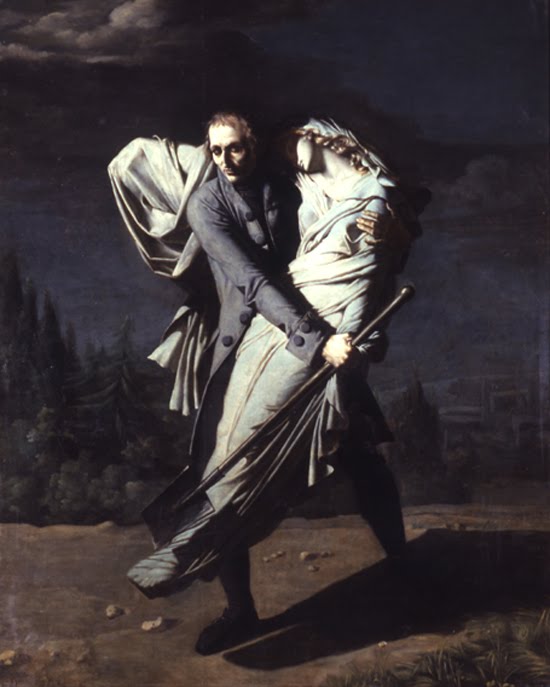Public domain permitting, there are countless editions of Mary Shelley’s novel to chose from, differentiated by various introductions and covers, though cover art tends to be repetitive. A gander at Amazon shows an inordinate number of Frankensteins illustrated with a picture of Boris Karloff, almost always in his burned face makeup from Bride of Frankenstein. When classic paintings are used, you can to expect Friedrich’s The Wanderer Above the Sea of Fog, brooding over a mountain maelstrom, or Fuselli’s The Nightmare, depicting a reclining woman with an imp on her chest and a horse head poking through the curtains.

The edition shown here, interestingly, is the only one I have found (at least so far) using this particular and strangely appropriate painting, Pierre-Auguste Vafflard’s Young et sa fille (Young and his Daughter), also called Young enterrant sa fille (Young Burying his Daughter), and known in English as Young Holding his Dead Daughter in his Arms.
The Paris-born Vafflard (1777-1837) was famous for overseeing art restorations made at Versailles and the Palais des Tuileries. Of his personal works, Young et sa fille is the best known and most admired because of its near monochromatic palette suggesting the pearly glow of moonlight. When Vafflard’s painting was first shown in 1804, a reviewer composed a verse about it to the tune of the French folk classic Au clair de la lune (By the Light of the Moon), celebrating the moonlight effect that made the painting so unique. In 1838, Young et sa fille was one of ten paintings donated by artist and collector François Ringuet to his home town of Angoulême, France, as the initial collection for the city’s Museum.
Appropriately for Frankenstein, the image of a man carrying a shovel and a dead woman wrapped in her shroud, evokes nightime grave robbing.
The apocryphal painting actually refers to a notorious incident from 1736. Elizabeth Temple, stepdaughter to English Romantic poet Edward Young, died while traveling through France. A Protestant, she was banned from interment in a proper cemetery — reserved exclusively for the catholic dead — and committed to a lowly Swiss graveyard. Vafflard imagined the outraged Young righting the wrong, re-burying Elizabeth.
Young’s sorrow would reach epic proportions when, in 1740, Elizabeth’s husband and then her mother, Young’s wife, also passed away. The poet, overwhelmed by accumulating grief, was driven to write a series of dark poems, fantastically popular, collected under the title Night Thoughts. A young Goethe was deeply influenced by Night Thoughts and French revolutionary Camille Desmoulins, awaiting the guillotine with his friend Danton, read Night Thoughts as preparation for death.
Vafflard’s Young et sa fille makes for a great Frankenstein cover, although considering the painting’s backstory, its inspiration drawn from a case of eighteenth-century catholic zealotry, it’s an intriguing choice for this particular publisher, Ignatius Press being a staunchly traditional, catholic publisher.
Ignatius Critical Editions version of Mary Shelley’s Frankenstein.





6 comments:
Very cool, Pierre.
And one of the most fitting choices I've ever seen, in the "PD Painting" cover sweepstakes.
(That could be Vic gathering bride parts in the Orkneys!)
Happy All Hallow's,
-Craig
Beautiful, sorrowful visual of poor overworked Victor, how many graves did he have to dig up before finding creature parts and pieces worthy of the beautiful bride? I do a little inanimate reincarnating and know of the endless battle to find just the right piece and knowing when to say "Done".
Amazing story and a fantastic cover. I need to search for this edition to add to my own Frankenstein collection.
Awesome blog, I just wanted to write, that I'm going to have some Frankenstein related stuff, periodically on my blog if you want to check it out.
Thanks
Thanks, Pierre. I've not seen that cover, or painting before. I'm sure if I'd seen it hanging on a museum wall I'd have leapt to the same conclusion that he'd just dug her up, and not that he was about to bury her, even though the clean blade of the shovel seems to indicate this is what's about to happen.
Thanks! (I am the cover designer for this series.)
For this particular series, the Ignatius Critical Editions, it has been difficult locating classic art that hasn't been used a dozen times already. I spent many hours sorting through art before I found this eerily appropriate painting for Frankenstein.
To me, at least, the context in which the art was created is secondary to the context it will be placed in for design purposes. For the cover, the figure could be Victor with the dead Elizabeth, or on the other hand, it could be Victor robbing a grave but possessed with grief for his actions. I think it works both ways.
Post a Comment